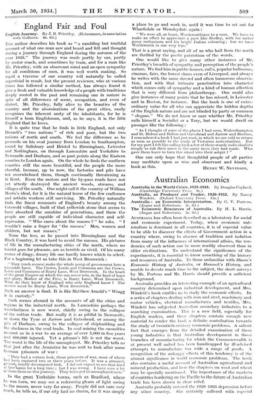Australian Economics
Australia in the World Crisis, 1929-1933. By Douglas Copland. (Cambridge University Press. 9s.) The Economic Resources of Australia. By H. L. Harris. (Angus and Robertson. 35. ad.) AUSTRALIA has often been described as a laboratory for social and economic experiment. Today, when economic nat- ionalism is dominant in all countries, it is of especial value to be able to discover the effects of Government action in a country where, owing to absence of tradition and isolation from many of the influences of international affairs, the ten-
dencies of such action can be more readily observed than in older civilizations. To understand the significance of the
experiments, it is essential to know something of the history and resources of Australia. To those unfamiliar with Shann's Economic History of Australia, or Hancock's History, and unable to devote much time to the subject, the short surveys by Mr. Porteus and Mr. Harris should provide a sufficient
background.
Australia provides an interesting example of an agricultural country determined upon industrial development, and Mrs.
Windett's book enables us to study the economic effects. In a series of chapters dealing with iron and steel, machinery and motor vehicles, electrical manufactures and textiles, Mrs. Windett has subjected Australian secondary industries to a searching examination. This is a new field, especially for English readers, and these chapters contain enough new material to render the book a definite contribution towards the study of twentieth-century economic problems. A salient fact that emerges from the detailed examination of these young industries is that Australian development in those branches of manufacturing for which the Commonwealth is at present well suited has been handicapped by ill-advised attempts to manufacture too wide a range of goods. A recognition of the unhappy effects of this tendency is of the utmost significance in world economic problems. The book also contains a useful account of Australian agricultural and mineral production, and here the chapters on wool and wheat may be specially mentioned. The importance of the markets
of countries bordering on the Pacific to the future of Australian trade has been shown in clear relief.
Australia probably entered the 1929-1933 depression before any other country. She certainly suffered with especial
severity from the calamitous fall of commodity prices, but today she is emerging from the depression more definitely than any other country, with the possible exception of Great Britain. Mrs. Windett, working upon statistical data, has been able to give an adequate picture of Australia from 1920 to 1931, but her raw material has not allowed her to do justice to the happier story of the last two years.
On the history of this period Professor Copland writes with peculiar authority, since he was actively concerned in the negotiations which led to the adoption of the " Premiers' Plan," under which Australia has succeeded in readjusting her economic life with extraordinary rapidity. Professor Copland's book is based on his Marshall Lectures delivered in Cambridge last autumn. He describes the high level of pro- sperity reached by Australia between 1925 and 1929, the impact of the crisis in 1930, and the succession of measures taken to adjust the economic life of Australia to the new conditions. To begin with, Australia sought to meet her obligations without any fundamental change in her internal policy. This phase is described by Professor Copland as the period of expediency to be succeeded later by " the ordered plan." The expedients used in this first stage of the battle were almost wholly defensive. They included the export of gold and the use of exchange reserves ; higher tariff duties and import re- strictions ; a pegged exchange, which most Australian economists regarded as overvaluing the currency, and an exchange pool to guarantee the service of the external debt. In the latter half of 1930 controversy raged between the exponents of deflationist and inflationist remedies. De- flation had the support of august authorities outside Australia who were anxious to prevent unorthodox financial develop- ments. The restriction of business activity and the loss in money wages . consequent upon deflationary action would, however, have been too severe to have been politically possible even had such methods been economically desirable.
The final Premiers' Plan actually adopted embodied a middle course. A reduction in real wages and in all salaries and pensions paid by Governments and a conversion of internal debt on the basis of a 22} per cent. reduction of interest were deflationary measures, while the depreciation of the Australian £ in relation to both gold and sterling by increasing the returns of the export industries such as wool, wheat and dairy produce, prevented unemployment from assuming unmanageable proportions.
There is no doubt that the financial crisis in Australia between 1930 and 1932 provides a most interesting and happy example of combined efforts by Governments and professional economists. Today in the wider field of the United States of America similar use is being made of the economist. Australia has fulfilled her role as an economic laboratory, and the books under review can be of help to those who desire to understand the significance of the great experiment from which she has successfully emerged.









































 Previous page
Previous page